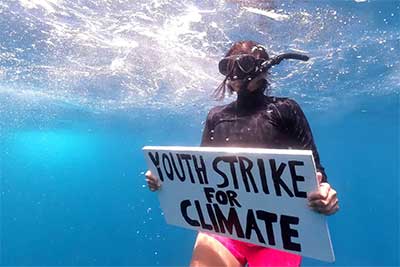World’s first underwater climate strike calls for ocean protection
World’s first ever underwater climate strike at the heart of the Indian Ocean took place recently. The protest took place at the Saya de Malha Bank, a climate-critical site owing to its vast seagrass meadows, 735km off the coast of Seychelles.
The bank is known to contain the world’s largest seagrass meadow, a major absorber of carbon dioxide. The area is also rich in wildlife, including sharks and pygmy blue whales. As a fish spawning ground it also plays an important role in maintaining the staple diets of millions in coastal communities across the region.
The credit for such vision goes to Young Mauritian scientist and climate advocate, Shaama Sandooyea. Through this initiative she demanded climate justice . Her message Was clearly incorporated “Youth Strike for Climate” . This message appealed that global leaders must commit to a network of ocean sanctuaries protecting at least 30% of our oceans.
Meanwhile Greenpeace is also calling for a strong Global Ocean Treaty to enable protecting at least 30% of the oceans by 2030 through a network of sanctuaries kept off limits to human activity.
Importance of seagrasses:
Seagrasses are aquatic plants found all over our world’s oceans and estuaries on every continent except Antarctica.
Seagrass beds are a major nursery for many species of fish, which benefit humans. In addition, they are home to large numbers of diverse organisms like turtles, eels, dugongs ( sea cow) , squid, manatees and crabs, to name just a few. The World needs plenty of marine biologist, plant ecophysiologist and chemical oceanographer to spread awareness to protect seagrasses across the globe. Seagrasses also filter water and produce oxygen. They control erosion by trapping soil and sand with their roots. In areas with intact seagrass beds, storms often do less damage to coral reefs and coastal lands because the seagrasses act as a buffer, absorbing energy from the waves.
Seagrasses, along with mangroves, coastal wetlands and salt marshes, form a tripartite protective barrier for shorelines — once this barrier is lost, shorelines erode into the sea. Seagrasses need clean water and sunlight to thrive. Nitrogen and phosphorous from sewage treatment plants, streets and farms can pollute coastal waters and cause blooms of algae that deprive seagrasses of light and clean water. Dredging and shoreline development also damage seagrass habitat.









